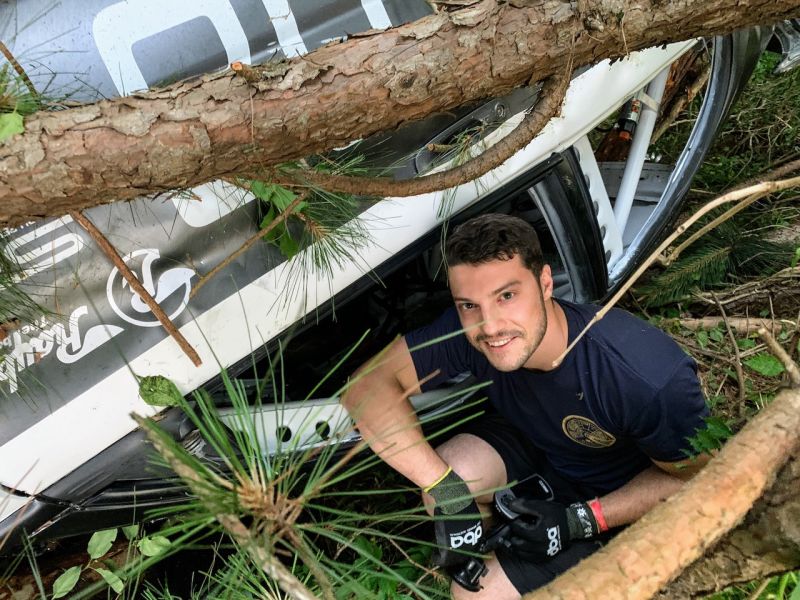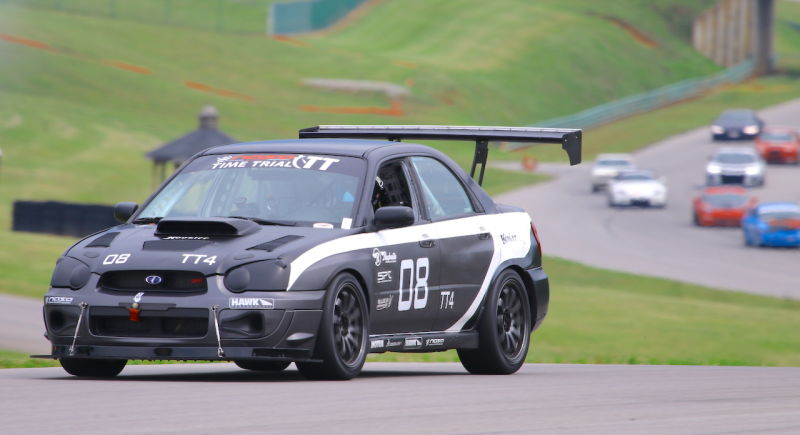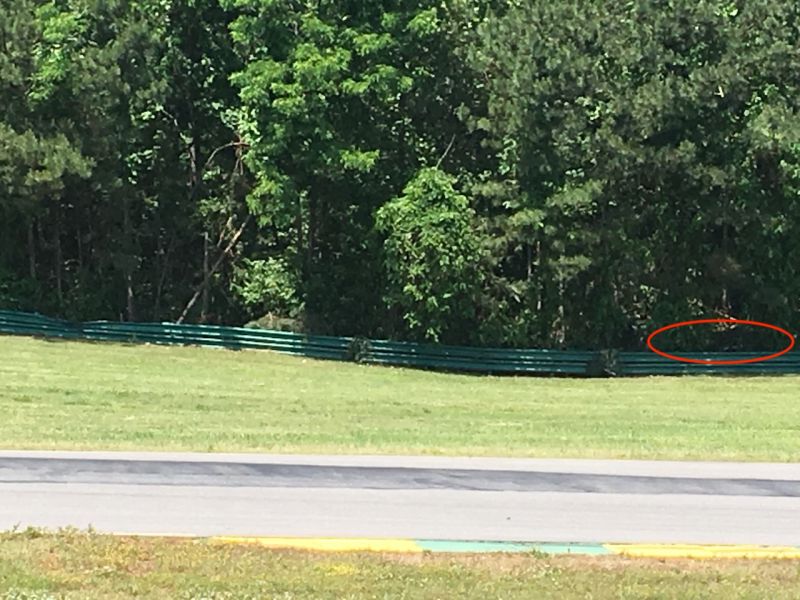
Zach walked up to me as I was checking a few things on my racecar prior to my group’s morning practice session at HyperFest. My staff radio was on the counter, inside my trailer, and I had missed the slightly frantic call from Turn 15’s corner worker, which normally would have been coming from my right hip at full volume.
“He’s okay? Any idea how bad it was?”
“No idea, but he’s fine and being checked out by medical for a bit.”
As safe as track weekends are, we do see drivers of all backgrounds and skill levels end up off the racing surface and in need of assistance from a few members of the emergency vehicle crew. Most times, a simple tow truck is all that’s needed. Unfortunately, my friend Tom ended up earning a “roll everything” call, resulting in several tow trucks, a fire truck, and an Advanced Life Support ambulance all heading to Turn 15 at full throttle as drivers sat, stopped, on the right side of the track under red flag conditions.
Before going further, we have to back up to NASA Mid-Atlantic’s final event of last year. In November 2018, Tom was charging down the front straight of Summit Point Raceway in a Time Trial session. As he entered the braking zone of Turn 1, he went for the brakes and felt the pedal sink to the floor. His Subaru WRX went on a ride through the grass, through a gravel trap, and impacted a tire wall head-on, hard enough to break through the concrete barricade behind it.
Though the WRX was wounded, it was able to be saved, as the damage was all ahead of the frame rails and the engine was not hurt. Tom spent the winter of 2018 and spring of this year getting his college-car-turned-racecar back into shape.
In investigating his random brake failure, Tom elected to replace quite a bit related to that system. With new brake caliper seals, bleed valves, banjo bolt washers, rotors, brake pads, and fluid, Tom elected to also replace the master cylinder. Following that work, with the nose of the car once again shaped like a Subaru, Tom sent the car a few hours south to a fabricator, where the bolt-in roll bar was replaced with a welded-in, whole-car roll cage.
With the roll cage finished, Tom spent the weeks prior to HyperFest hammering away at last-minute details. HyperFest was the car’s first event with a full cage.

NASA’s Time Trial program is positioned as an “in between” offering, for those who are ready to move beyond the guided instruction of High Performance Driver Education and explore some elements of competition. Drivers compete for the best lap time in their class, and do not race wheel-to-wheel. If everyone is ordered by best lap time in the grid, there tends to be very little passing. It’s a relatively safe atmosphere, and as a result, completely stock street cars can be used to compete.
Those Time Trial drivers who find themselves pushing hard, event after event, tend to explore their safety options with more intent. Some compete in TT while slowly preparing their car for wheel-to-wheel racing, which requires a full roll cage and other safety gear. Others just like the peace of mind that a roll bar, racing seat, and six-point harness provide. In any case, the level of preparation is up to the driver, and not mandated.
As Tom was preparing his Subaru for NASA’s Super Touring wheel-to-wheel racing class, he was required to have a full roll cage installed. These cages are made of steel tubing, welded together and then welded to the unibody of the car. The idea is that in the event of a crash, the car may deform around the roll cage, leaving the passenger compartment intact. There are bars across the roof, near the doors, and by the driver’s feet, all to prevent serious intrusion.
NASA racecars must also have a window net, which prevents debris from entering the driver’s window and can help contain the driver’s arms to an extent. Racing seats must have a “halo” design, which keeps the driver’s head from moving side to side. Drivers must wear a head and neck support, to prevent excessive head movement front-to-back, protecting the spine.
The Saturday morning of HyperFest did not see Tom taking the green flag with the intent to test his safety systems. But, intent doesn’t always match reality. Tom completed several fast laps that morning, and the Subaru was running well. Toward the end of the 15-minute session, though, Tom was approaching the end of the back straightaway. Before the braking zone, he gave the brake pedal a light tap to check for pressure, and it felt good.
Tom entered the braking zone just north of 130 mph, and applied the brakes. As in November, the middle pedal went straight to the floor. He tried pulling it back up and pumping it again. The WRX had nothing to give.
He left the track surface and went through the vast grassy runoff by Turn 15. Between morning dew and overnight rain, the grass was slick, and the car kept sliding. Tom took his hands off the steering wheel and grabbed his chest harnesses. As the Subaru approached the guardrail at the end of the runoff, the car hit a small rut and the nose popped up a bit. The car impacted the guardrail, spun around mid-air and impacted trees behind the guardrail. It continued spinning to the right, through more trees, dissipating energy as it went. The car came to rest upside-down on the front driver’s side.

Tom unlatched his harnesses, crawled out the passenger front window, and was met by the “roll everything” emergency crew. He was placed in the ambulance and evaluated immediately, then kept in VIR’s medical building for further evaluation over the course of an hour. He was sore from the harnesses, but otherwise okay.
I’ve worked for NASA Mid-Atlantic since 2008, and seen a number of rolled cars in that time. Tom’s crash is one of only two that has required trees be cut down to extract the car. In both cases, the drivers walked away from the carnage. Tom and I, along with our friend Taylor, brought Tom’s trailer out to the crash site on Saturday evening. Emergency crews hooked a chain to the rear hoop of the roll cage and pulled the WRX out of the woods, loading the car directly onto his trailer.
Gray Subaru #08 will not be resurrected again. It gave its life to save that of its driver, and all of the safety gear that Tom spent his hard-earned money on worked together in that effort.
Tom’s competitive future is undecided, but he’s not letting the loss of #08 bring down his go-fast spirit. Talks of Spec Miatas and various BMWs are already coming to light, and we hope to see him back in the driver’s seat, racing wheel-to-wheel, in early 2020.
As with any incident on track, “thank you” is not enough for the hard-working EV staff. The dedication of the teams, who are often volunteering at these types of events, does not go unnoticed.
For those with a few extra dollars to spare, Taylor and I have set up a GoFundMe to help Tom fund his new safety gear when the time comes.
See more at Out Motorsports, a site created to not only share the pursuits of LGBT motorsports competitors, but to encourage others to get behind the wheel and participate as their full selves.